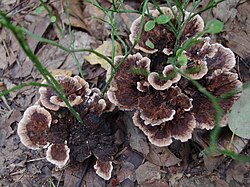fr
noms dans le fil d’Ariane


Hydnellum concrescens is an inedible fungus, commonly known as the zoned hydnellum or zoned tooth fungus. As with other tooth fungi, the spores are produced on spines on the underside of the cap, rather than gills. It has a funnel-shaped cap, typically between 2 and 7 cm (0.79 and 2.76 in) in diameter, which has characteristic concentric zones of color. The cap may also have radial ridges extending from the center to the margins. The spines are pink in young specimens, but turn brown with age.
This species is very similar in appearance to Hydnellum scrobiculatum, and traditionally, largely unreliable microscopic characteristics such as spore size and ornamentation have been used to distinguish between the two. Recent research has demonstrated a way to discriminate the two species using DNA sequencing of the ITS regions.[1]
Hydnellum concrescens is an inedible fungus, commonly known as the zoned hydnellum or zoned tooth fungus. As with other tooth fungi, the spores are produced on spines on the underside of the cap, rather than gills. It has a funnel-shaped cap, typically between 2 and 7 cm (0.79 and 2.76 in) in diameter, which has characteristic concentric zones of color. The cap may also have radial ridges extending from the center to the margins. The spines are pink in young specimens, but turn brown with age.
This species is very similar in appearance to Hydnellum scrobiculatum, and traditionally, largely unreliable microscopic characteristics such as spore size and ornamentation have been used to distinguish between the two. Recent research has demonstrated a way to discriminate the two species using DNA sequencing of the ITS regions.
Vyöhykeorakas (Hydnellum concrescens) on nahkaorakkaisiin kuuluva sieni, joka kasvaa yleensä kosteissa havumetsissä karikkeenlahottajana. Sen itiöemä on ruskea, reunasta vaaleampi, usein kiiltäväkin, ja yläpinnalla on sekä sisäkkäisiä vyöhykkeitä että säteittäisiä juomuja. Alapinta on suunnilleen samanvärinen, samoin hoikahko jalka. Piikit ovat hentoja ja ulottuvat johteisesti jalkaan. Itiöemän muoto on epäsäännöllisen suppilomainen, ja kasvaa päällekkäin ja limittäin toisten itiöemien kanssa. Malto on pehmeää eikä maussa ole karvautta. Haju on ominainen, seetripuumainen. Laji ei ole ruokasieni.[2]
Vyöhykeorakas (Hydnellum concrescens) on nahkaorakkaisiin kuuluva sieni, joka kasvaa yleensä kosteissa havumetsissä karikkeenlahottajana. Sen itiöemä on ruskea, reunasta vaaleampi, usein kiiltäväkin, ja yläpinnalla on sekä sisäkkäisiä vyöhykkeitä että säteittäisiä juomuja. Alapinta on suunnilleen samanvärinen, samoin hoikahko jalka. Piikit ovat hentoja ja ulottuvat johteisesti jalkaan. Itiöemän muoto on epäsäännöllisen suppilomainen, ja kasvaa päällekkäin ja limittäin toisten itiöemien kanssa. Malto on pehmeää eikä maussa ole karvautta. Haju on ominainen, seetripuumainen. Laji ei ole ruokasieni.
Kolczakówka strefowana (Hydnellum concrescens) – gatunek grzybów należący do rodziny kolcownicowatych (Bankeraceae)[1].
Pozycja w klasyfikacji według Index Fungorum: Hydnellum, Bankeraceae, Thelephorales, Incertae sedis, Agaricomycetes, Agaricomycotina, Basidiomycota, Fungi[1].
Po raz pierwszy takson ten zdiagnozował w 1796 r. Persoon nadając mu nazwę Hydnum concrescens. Obecną, uznaną przez Index Fungorum nazwę nadał mu w 1906 r. Banker[1].
Nazwę polską nadali Barbara Gumińska i Władysław Wojewoda w 1983[2]. Odnosi się ona do kolczastego hymenoforu i strefowanej powierzchni kapelusza. Łacińska nazwa gatunkowa concrescens odnosi się do jego skłonności do zrastania się kapeluszy[3].
2-10 cm średnicy, wgłębiony do lejkowatego, promieniście zmarszczony. Często wewnątrz lejkowatego owocnika tworzą się promieniście ułożone następne, mniejsze lejki lub wyrostki, czasami też sąsiednie owocniki zrastają się z sobą. Powierzchnia koncentrycznie i różnobarwnie strefowana, naga, aksamitna lub włókienkowata, z jaśniejszym brzegiem. Ma barwę od różowobrązowej do ciemnobrązowej[3].
Kolczasty. Kolce zbiegające na trzon, na końcach jaśniejsze, do 3 mm długości. Początkowo są białawe, później brązowe do ciemnobrązowych[3].
Wysokość 2-4 cm, grubość 2-5 cm, kształt zwykle beczkowaty, barwa taka sama jak kapelusza[3].
Podobnej barwy jak kapelusz, słabo strefowany, skórzasty, korkowaty, w końcu zdrewniały. Bez zapachu, lub zapach niewyraźny[3].
Brązowy. Zarodniki brązowawe, kuliste lub nieregularne, o rozmiarach 4-7 μm[3].
Występuje w Ameryce Północnej i Środkowej, Europie, Azji i Australii[4]. W Polsce rzadki, podlegający ścisłej ochronie gatunkowej[5]. Znajduje się na Czerwonej liście roślin i grzybów Polski. Ma status E – gatunek zagrożony wymarciem[6]. Znajduje się na listach gatunków zagrożonych także w Szwajcarii, Niemczech, Danii, Anglii, Holandii, Norwegii, Słowacji[2].
Rośnie na ziemi w lasach liściastych, iglastych i mieszanych, wśród mchów lub opadłego igliwia, czasami także wśród wrzosów i w lasach bukowo-jodłowych. W Polsce owocniki wytwarza od sierpnia do października[2].

Kolczakówka strefowana (Hydnellum concrescens) – gatunek grzybów należący do rodziny kolcownicowatych (Bankeraceae).